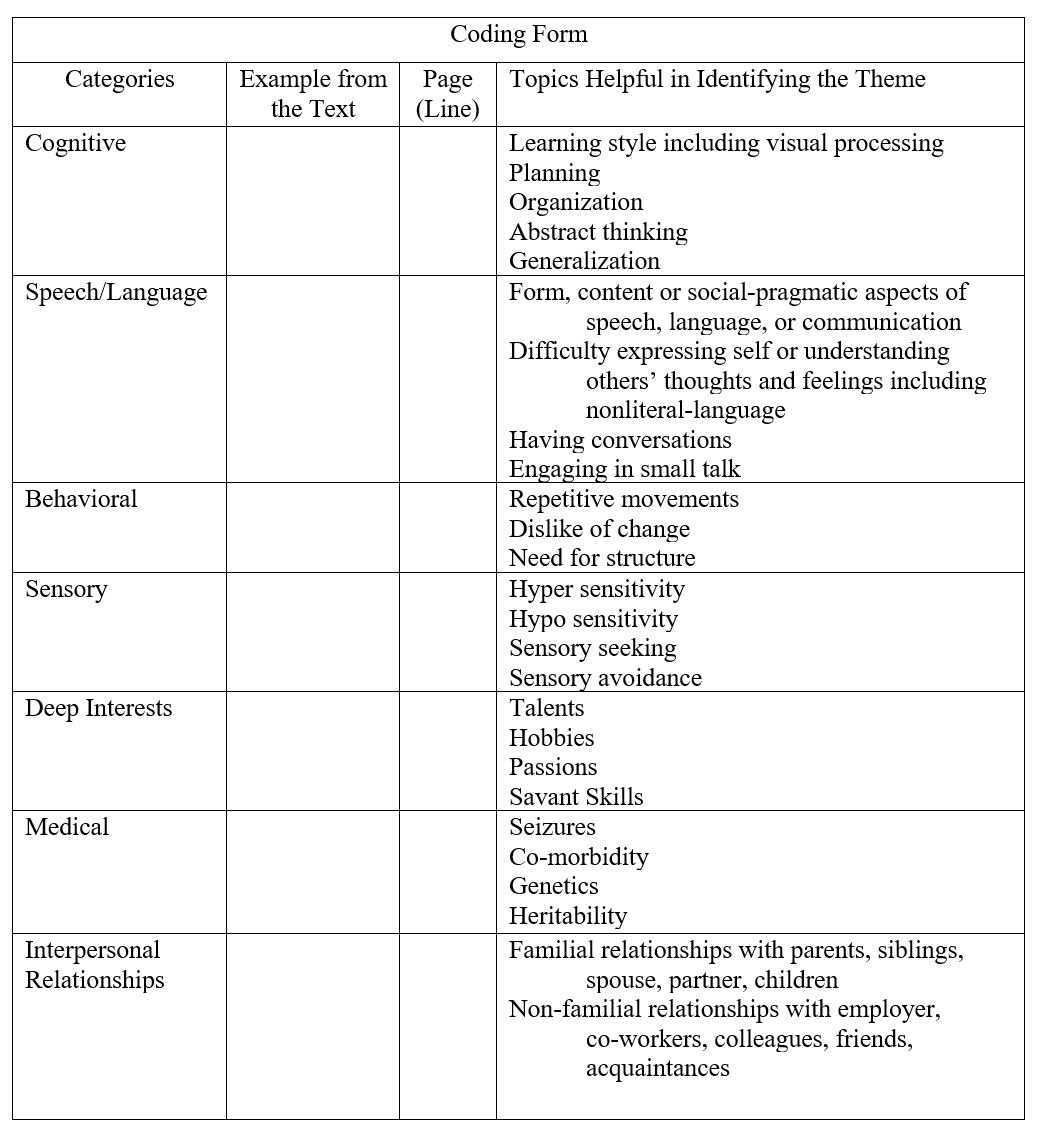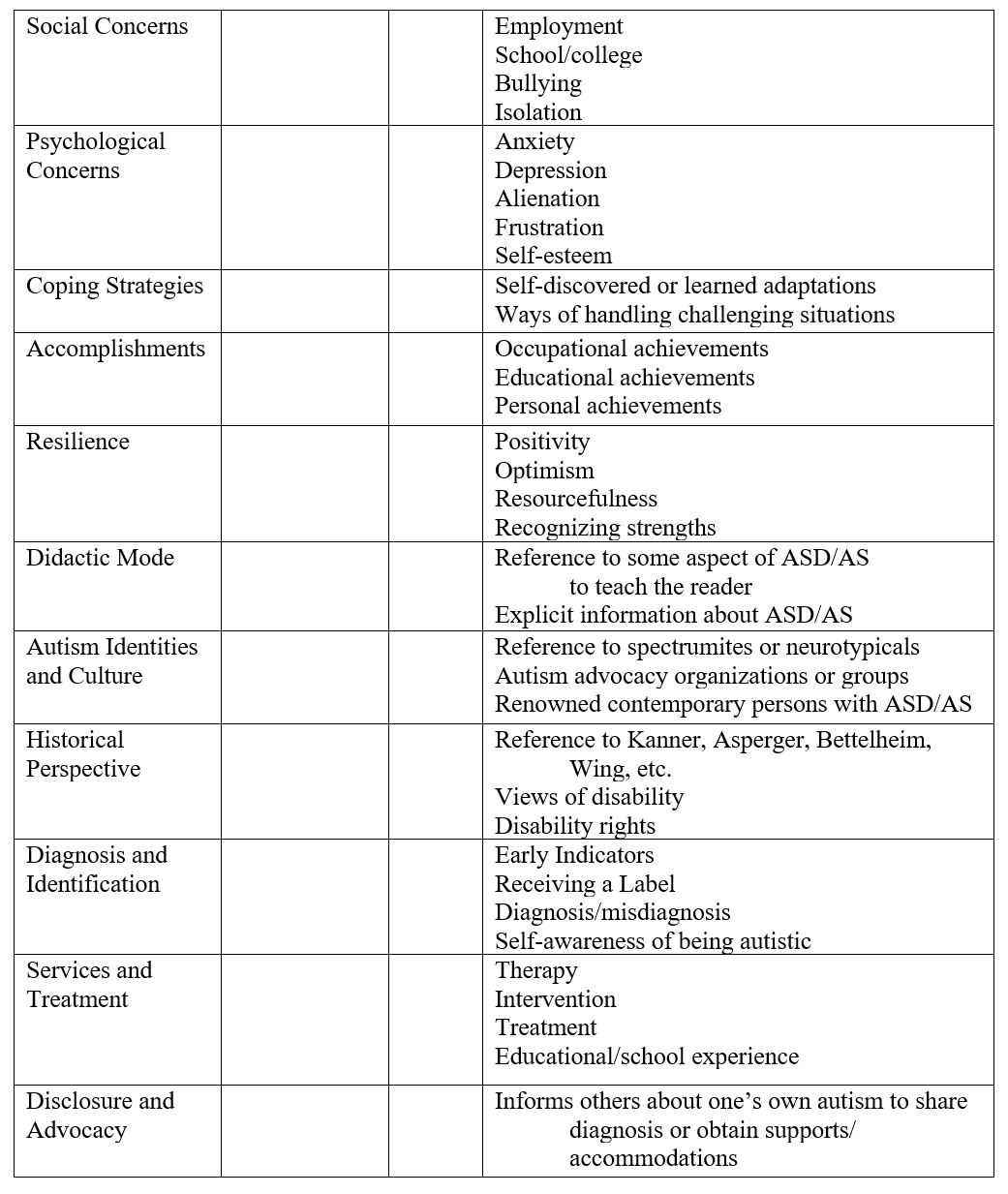Autobiographical Accounts from the Autism Spectrum
By Susan Longtin, Ph.D., CCC- SLP, TSHH
Associate Professor & Chair, Communication Arts, Sciences, and Disorders, CUNY, Brooklyn College
& Elyse Bell Opila, M.S.
CUNY, Brooklyn College
Abstract
This investigation of the autism spectrum disorder (ASD), a complex neurodevelopmental disability, and autism spectrum used a thematic content analysis to identify the topics, ideas, and concerns in twelve full-length autism autobiographies published between 1994 and 2012, with an eye toward the feasibility of using the autobiographies as teaching tools for students in pre-service clinical fields. Portions of text that were coded into content categories were counted within each book and summed across the books. The investigators identified 1,989 instances of text described by 18 different content categories, organized into five broad themes, which were represented across the books. The autobiographies varied in the degree to which they emphasized particular content. The authors conclude that these personal accounts can enhance the education of pre-service students in various clinical fields and provides them with the inside perspective of life on the autism spectrum.
Keywords: autism, Asperger syndrome, autobiographies, themes
The research reported in this paper was sparked by a student’s question in a graduate course, “Speech, Language, and Communication in Individuals with Autism,” taught by the first author of this article as part of an accredited master’s program in the applied clinical field of speech-language pathology. The student posed the following query: “What do people with autism think about being autistic?” Not knowing the answer to that question, the professor suggested that the student read some first person accounts from the growing body of autism autobiographies. These autobiographies could complement the information in the traditional clinical literature found in textbooks and journal articles, which often emphasize the characteristics of the disorder from a deficit perspective and focus on clinical educational issues. Autobiographies are useful for teaching students about autism because they reflect the voice of the only true “autism experts” (Kluth, 2004, p. 43) providing rich examples of some clinical phenomena such as savantism (Draaisma, 2009). These autobiographies enable the reader to better understand the autistic experience and empathize with those on the spectrum (Bates, 2010). Embracing these autism autobiographies could expand students’ “ports of entry” (Stern, 1995) by providing a relationally oriented perspective to enable students to more deeply understand, appreciate, and explore the accomplishments, identities, and culture of the population.
Medical and Social Models
Autism spectrum disorder (ASD) is a complex neurodevelopmental disability, with a prevalence of 1 in 59 children in the United States (Baio et al., 2014). The medical model of disability, which is grounded in the American Psychiatric Association’s Diagnostic and Statistical Manual of Mental Disorders-fifth edition (2013) and its earlier editions, emphasizes disorders and deviations from the norm, framing the condition as a problem. Too often, this notion of impairment is the dominant discourse in clinical education. A Practical Guide to Autism (Volkmar & Wiesner, 2009) and the Handbook of Autism and Other Developmental Disorders (Volkmar, Rogers, Paul, & Pelphrey, 2014) are examples of textbooks with this dominant deficit orientation. The social model of disability, in contrast, views autism as a naturally occurring human variation, which represents differences but not necessarily deficits (Kern- Stähler & Thiemann, 2015). The differences are relative to the characteristics of the so-called “neurotypical” population, a term for Brownlow, 2010). The neurodiversity perspective “focuses on overall quality of life, recognizes positive aspects of autism, and acknowledges autism as a human experience” (Tomlinson & Newman, 2017, p. 93). Autism: A New Introduction to Psychological Theory and Current Debate (Fletcher-Watson, & Happé, 2019) is an example of a textbook that is more aligned with the social model of disability since it includes the voices of those on the spectrum and their families. This resource provides a contemporary understanding of autism for students and practitioners who work in educational and clinical settings. Scholars in various fields including cultural and literary studies (Van Goidsenhoven, 2017), geography (Davidson & Henderson, 2010), gender studies (Jack, 2012), phenomenology and philosophy (Costa & Grinker, 2018) and disability studies (Couser, 2011) have explored autism autobiographies. Embracing diverse fields of inquiry expands and enriches students’ perspectives on the condition.
Autism Autobiographies
Personal narratives, including full-length autobiographies, describe the experiences of those who have written their stories “in the context of family, culture, environment, and community” (Garden, 2010, p. 22) and attend to “the personal, the specific, and the particular” (Kramp, 2004. p. 72). The growing subset of published “autie-biographies” (Rose, 2005) reflects the voices of those on the spectrum. First among these was Temple Grandin’s Emergence (1986), co-written with Rosemary Scariano, which was instrumental in laying the groundwork for later autism autobiographies (Foss, 2009). This genre provides a form of “autistic textual self-representation” (Rose 2008, p. 45) for those on the spectrum.
Published autism autobiographies also serve a non-autistic audience, wherein “the authors seek to ‘explain’ the condition” (Murray, 2008, p. 5). Costa and Grinker (2018) note that autistic individuals not only wish to explain themselves to others, but also why they behave in ways that others might consider atypical. In this way, published autism autobiographies create pathways of communication between those who are on the spectrum and those who are “off the spectrum” (Davidson & Henderson, 2010, p. 464). Pre-service students in various clinical or educational fields, such as the student mentioned in the opening paragraph of this article, would be a prime example of those who would benefit pedagogically from these narratives by exposure to an alternative discourse about disability. For example, Shore, claims that he wrote his autism autobiography to promote “greater mutual understanding among society of life on and slightly to the right of the autism spectrum” (2003, p. 184). In reflecting on writing her life story, Prince-Hughes notes, “many high-functioning autistic people, unable to communicate with others about the ringing swirl, shout across cannons of reality by writing” (2004, pp. 25-26). The preference for written over spoken communication has been expressed by other autism authors including Williams, Willey, and Lawson (Van Goidsenhoven & Masschelein, 2016). Hacking suggested that “stories about people with autism, told by the people themselves” (2009, p. 1467) benefit those who might have limited direct interactions with persons on the spectrum such as the graduate student mentioned at the beginning of this article.
Thematic Analysis
Thematic analysis is a qualitative methodology, which focuses on the content of the narrative rather than its form or structure. This method of inquiry is well suited to understanding how a disability impacts the “feelings, beliefs, and attitudes of the affected person” (Maxwell & Satake, 2006, p. 247). In discussing various traditions of inquiry in qualitative research, Damico and Simmons-Mackie (2003) note that biographical study provides insight into historical, sociological, and cultural context of a person’s life history. A number of researchers have conducted qualitative thematic content analyses of autism autobiographies. Foss investigated several autism narratives including Grandin & Scariano’s Emergence, (1986), Prince-Hughes’s (2004) Songs of the Gorilla Nation, and Robison’s (2008) Look Me in the Eye noting that “the diagnosis seems to open up rather than delimit” the full potential of the authors (Foss, 2009, p. 11). Foss identified topics related to the diagnosis and the subsequent self-identification as someone on the spectrum. In addition, the analysis indicated that the authors wrote about their unique challenges, differences, strengths, resilience, and accomplishments.
Vincent et al. (2017) conducted a thematic content analysis of the unpublished autobiographies of eight university students with ASD, which identified the students’ concerns about their higher education experience. The students wrote about their difficulties in establishing social interactions with their peers, “unease and apprehension” in social situations, “nervousness, loneliness, and social anxiety” (Vincent et al., 2017, p. 309). Despite their challenges, the participants’ writing expressed a sense of optimism and resilience. In addition, Vincent et al. (2017) identified sensory issues as a major concern of university life-writers, reporting that “for some students, sensory issues—loud noises, intense lighting, and overcrowding—created significant barriers to social interactions” (p. 309). Other investigators also noted the topic of sensory differences in autistic autobiographical writings. For example, using the works by four different autistic autobiographers, namely, Grandin (1986), Williams (1992; 1994), Mukhopadhyay (2000), and Tammet (2006), Hacking (2009) found that these works include information about these authors’ hypersensitivities. In addition, Conn (2015) found that sensory issues informed the development of play and friendship in the published autistic autobiographies that she analyzed, namely, Daniel Tammet’s Born on a Blue Day, Jen Birch’s Congratulations! It’s Asperger Syndrome, Wendy Lawson’s Life Behind Glass, Donna Williams’s Nobody Nowhere, Liane Holliday Willey’s Pretending to be Normal, Dawn Prince-Hughes’ Songs of the Gorilla Nation, and Jon Elder Robison’s Look Me in the Eye. Conn found that the autistic autobiographies revealed the various ways in which sensory rather than social aspects of play engage autistic children, concluding that the latter aspect of play was secondary to the former for these children.
The geographers Davidson and Henderson (2010) also identified the topic of sensory differences in various genres of autism writings including full-length autobiographies. One theme that emerged from their qualitative analysis was the emphasis on “difference” rather than a “deficiency, disability, and deviance” (p. 465). In addition, the investigators found that these writings consistently provide information about strategies for “sensory survival” (p. 466). Like other investigators, Davidson and Henderson note that some of the authors emphasize skills and strengths that are associated with autism, such as being detail oriented.
Causton-Theoharis, Ashby, and Cosier (2009) focused on the single topic of social interaction in seven autism autobiographies, four of which Conn (2015) analyzed, namely those by Tammet, Williams, Prince-Hughes, and Robison. Causton-Theoharis et al. (2009) reported that these autistic authors’ challenges in social interaction were related to their differences in the sensory domain noting that difficulties arose from “unconventional responses to sensory information,” deep interests, and a need for predictability (Causton-Theoharis et al., 2009, p. 88).
Cognition is a domain that has been addressed in both the scientific literature on autism and in autism autobiographical analysis. Psychologists Happé, Briskman, and Frith (2001) suggest that people on the autism spectrum have a “central coherence deficit,” which is a tendency to focus on smaller details at the expense of the larger perspective. In addressing this cognitive problem, Costa and Grinker (2018) note that several autie-biographies counter this notion. Drawing on personal accounts, including those by Blackman (2001), Higashida (2013), Mukhopadhyay (2011), Shore (2003), and Tammet (2006), the investigators provide evidence that these autistic individuals are, indeed, cognitively competent. For example, Shore’s (2003) account includes his “experiences of ‘agency,’ ‘authorship,’ ‘self-awareness,’ ‘self-knowledge,’ et cetera” (Costa & Grinker, 2018, p. 168), abilities that are incompatible with a central coherence deficit in autism.
Dunn and Burcaw (2013) analyzed the published narratives of six individuals with different disabilities, including one with autism (as cited in Saperstein, 2010). Like the other investigators, these researchers used a thematic analysis to explore the writers’ concerns. They reported that discrimination was a dominant theme in the narrative of the autistic author who “struggled through college and had difficulty securing and maintaining a job” (Dunn & Burcaw, 2013, p. 153) facing challenges in the social demands of higher education and employment.
The review of the above literature indicates that autism autobiographies provide insight into the topics, issues, and concerns of those on the spectrum. This suggests that this genre of life writing could serve as a pedagogical tool to enhance pre-service clinical education. However, further research is warranted using additional books that were not previously investigated and additional categories. Several previous studies focused on only one topic, such as sensory issues, for example, Conn (2015), Davidson and Henderson (2010), Causton-Theoharis, Ashby, & Cosier (2009); or cognitive differences (Costa & Grinker, 2018). An investigation into a wider range of content areas expressed in the life writings of the autistic autobiographers is merited to explore the feasibility of using these books as a teaching tool to supplement textbooks and journal articles. Specifically, the present investigation analyzed the themes and content categories in twelve autism autobiographies, four of which have not been previously analyzed, with an eye toward determining if this genre of life writing could be a tool for teaching students in applied clinical fields. The investigators approached the analysis of the autism autobiographies without a priori pre-determined categories. The research was focused on exploring the following questions:
- What consistent topics, ideas, and concerns emerge in selected autism autobiographies?
- Which categories are most prevalent in particular autism autobiographies?
- Which broad-based themes capture the content of the autobiographies?
Methodology
Autobiography Selection
The database for this research consisted of twelve autobiographies written by adults with autism and published in English between 1994 and 2012 (see Table 1), the years in which Asperger’s disorder appeared the Diagnostic and Statistical Manual of Mental Disorders-fourth edition (American Psychiatric Association, 1994). The titles of eight of the books indicate that their authors had Asperger’s syndrome (AS), which is referred to as Asperger’s disorder in the medically oriented literature. The other four titles specified that their authors had autism. Seven authors were female and five were male. The age of the authors at the time of publication ranged from 28 to 57 years. Books written by those who had not reached adulthood by the time of publication were excluded. Only books written in English were included. The list of included autobiographies emerged organically from a combination of investigator familiarity, student interest, colleague recommendation, and autism advocacy organization websites. The books were published when the course referred to in the introduction was offered. The investigation included four autobiographies that were not previously analyzed. Collections of autobiographical essays, poems, letters, and online discussions were excluded. The selected books ranged in length from 118 to 295 pages. Table 1 lists the citation for the twelve books, the age of the authors at the time of publication, and the dominant categories that appeared in each book.
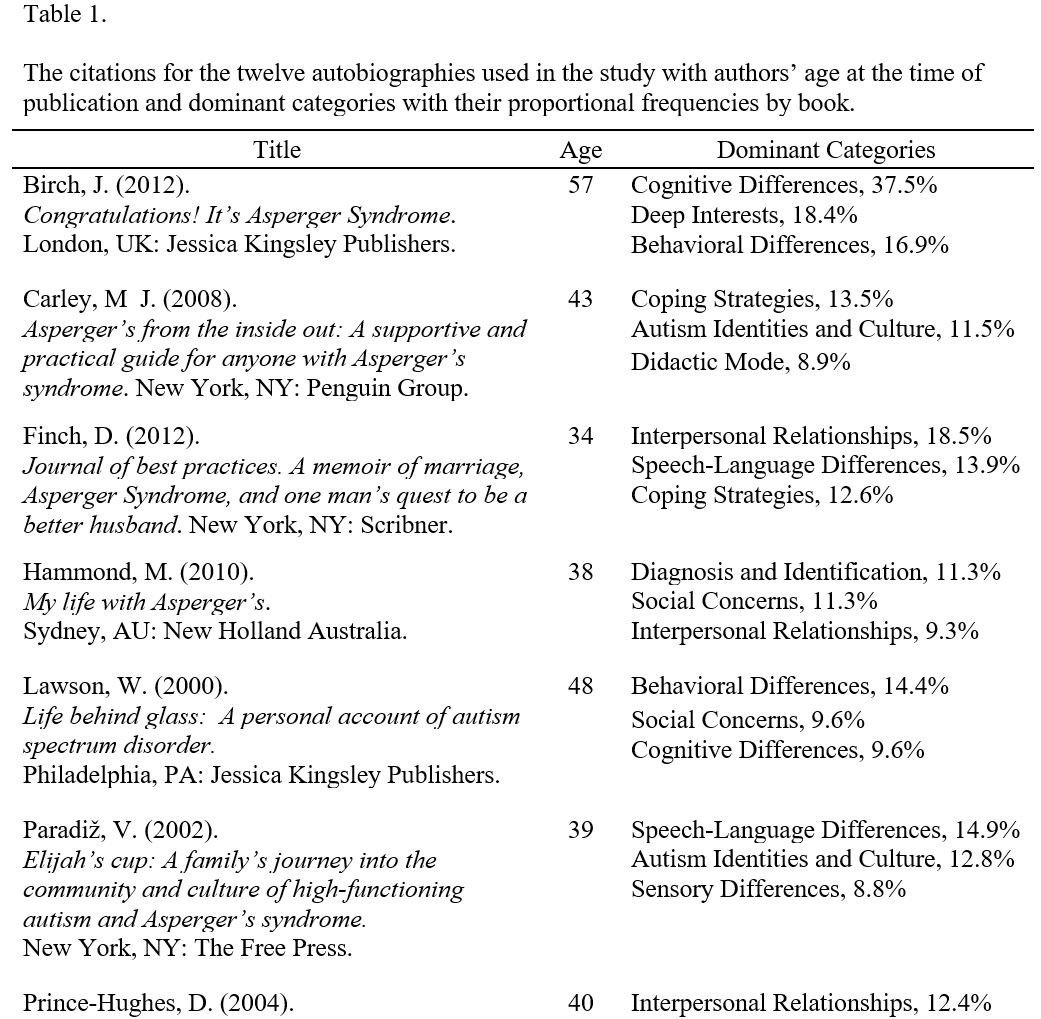
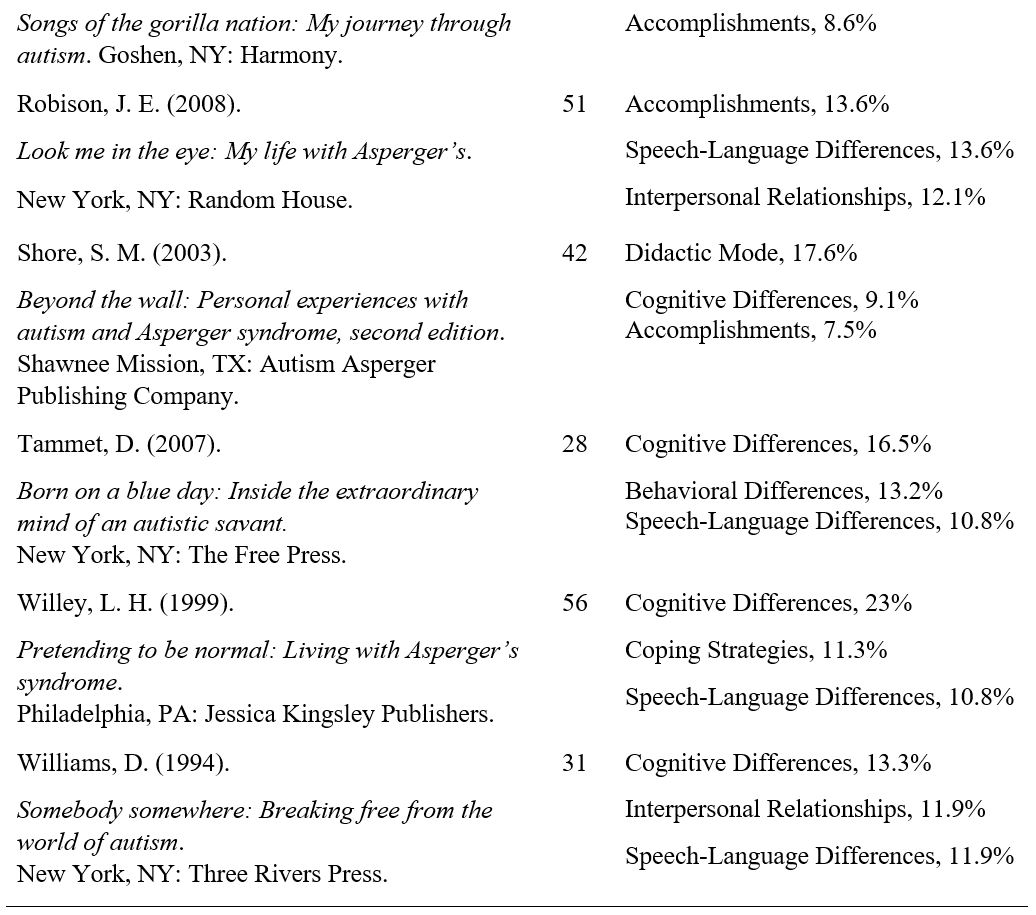
Analysis Procedures
This research blended qualitative and quantitative analysis procedures. The qualitative analysis sought to identify recurrent content categories based on procedures described in Maxwell and Satake (2006), and was conducted in stages described in Braun and Clarke (2006). The analysis did not begin with a list of preconceived categories that appeared in previous autism autobiographical research. Rather, the authors developed the categories based on what emerged from their reading of the texts. At the time of the course, neither the instructor nor the students were familiar with the research literature on autism autobiographies. This project developed spontaneously out of student interest in a graduate level course. The first author of this investigation and two graduate students enrolled in the course (a) each read four of the autobiographies, namely, Prince-Hughes (2003), Robinson (2008), Tammet (2007), and Williams (1994) and tagged sections of the text noting initial topics or ideas; (b) generated initial codes from the identified segments collating relevant data; (c) identified potential topics categories from the coded data; (d) reviewed the categories and recoded the data as necessary; (e) defined and named the categories, and (f) organized them into broader, hierarchical themes. For example, in the first reading of Robison (2008), the first investigator put topics, events, and concerns on a list, which eventually evolved into 18 categories that were identified across most of the books. The list included topics such as difficulty having conversations, engaging in small talk, understanding the thoughts and feelings of others, and understanding nonliteral language. These topics were collapsed into the speech-language category, which was subsumed under the broader, hierarchical Differences theme.
The quantitative methodologies used in this study consisted of the process of counting the number of instances of text that fell into the specific categories and broader themes. The entries were counted within each book and summed across books. Absolute and proportional frequencies were calculated for each category and theme.
Coding Forms. The first author developed a template that included 18 categories that were subsumed under five broad themes. The coding form assisted in the organization of examples of text that represented the categories and their eventual quantification. One coding form was used for each autobiography. The coding form listed key phrases that aided in identifying the categories. For example, the phrases “early indicators” and “receiving a label” were written on the coding form for the diagnosis/identification category. The page and line number where the selection of relevant text began were entered on the coding form. The codes captured most of the content of each book. The length of the portions of continuous text that reflected a particular category varied from a single paragraph to a few pages. The template that was used for coding appears in the Appendix.
Verification and Reliability of the Coding. Reliability of the coding was ascertained by having two readers independently code the same four autobiographies, namely Lawson (2000), Paradiž, (2002), Robison (2008), and Shore (2003). Using the formula number of agreements/(number of agreements + disagreements) X 100, reliability was 92%. In addition, ten readers, who were graduate students enrolled in an autism certificate program and trained on the coding system in a subsequent semester, were asked to identify five instances for each of the 18 categories from one of five of the selected autobiographies, namely, Lawson (2000), Paradiž, (2002), Robison (2008), Shore (2003), or Willey (1999). The ten student readers verified the codes by identifying five instances of text for each of the 18 categories. Their successes in identifying such examples suggest the psychological reality of the codes.
Results
Data
The readers identified 1,989 examples of text in the books that were organized into 18 different categories subsumed under five broad themes. Figure 1 provides a visual overview of the organizational framework for the data analysis.

Figure 1. The category by theme organizational framework that emerged from the autobiographies with the number and percent of instances of each category across the twelve books
The first research question asked what consistent topics, ideas, and concerns emerged in the autism autobiographies; these categories are listed in table 2, with their descriptions and examples from the texts.
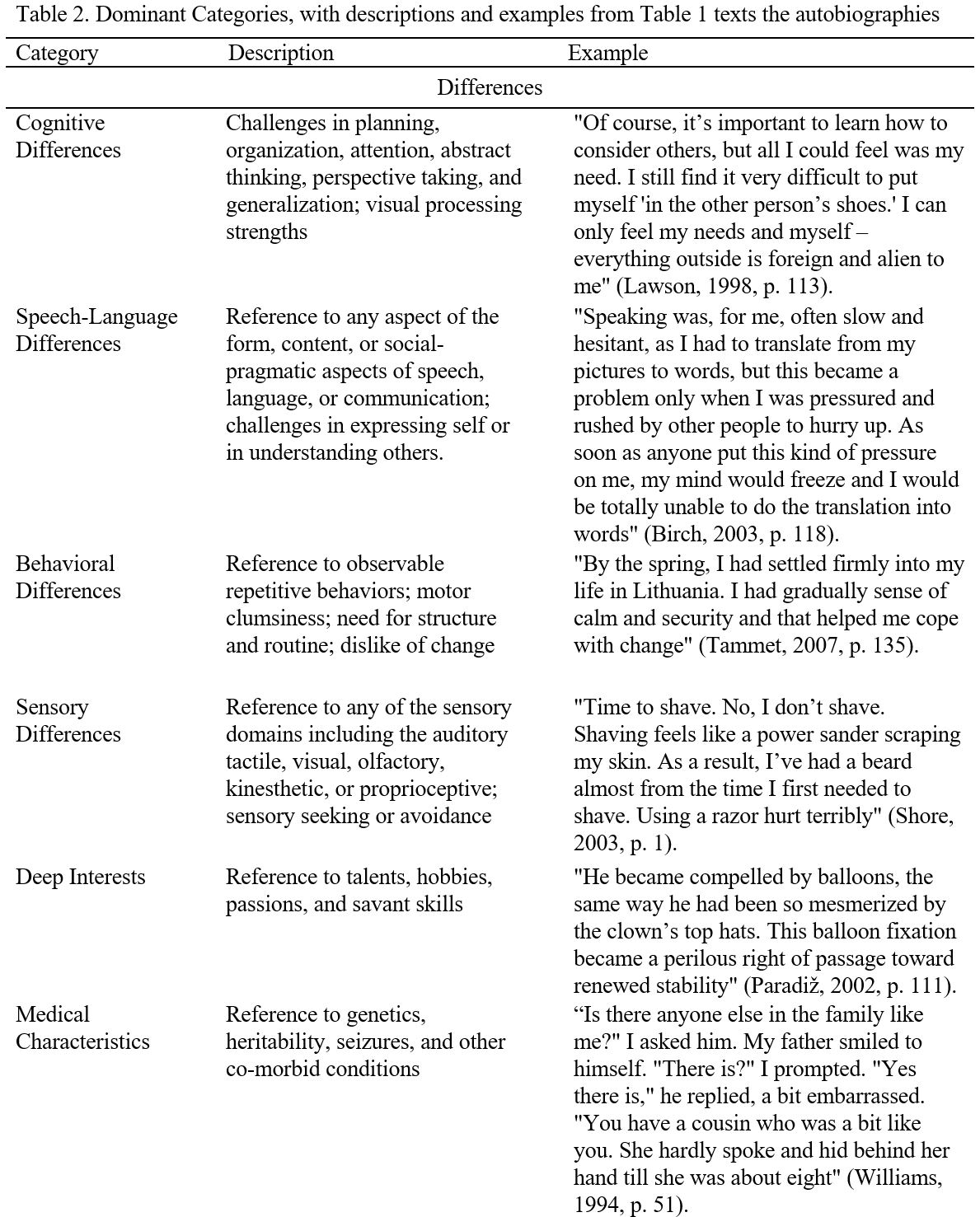
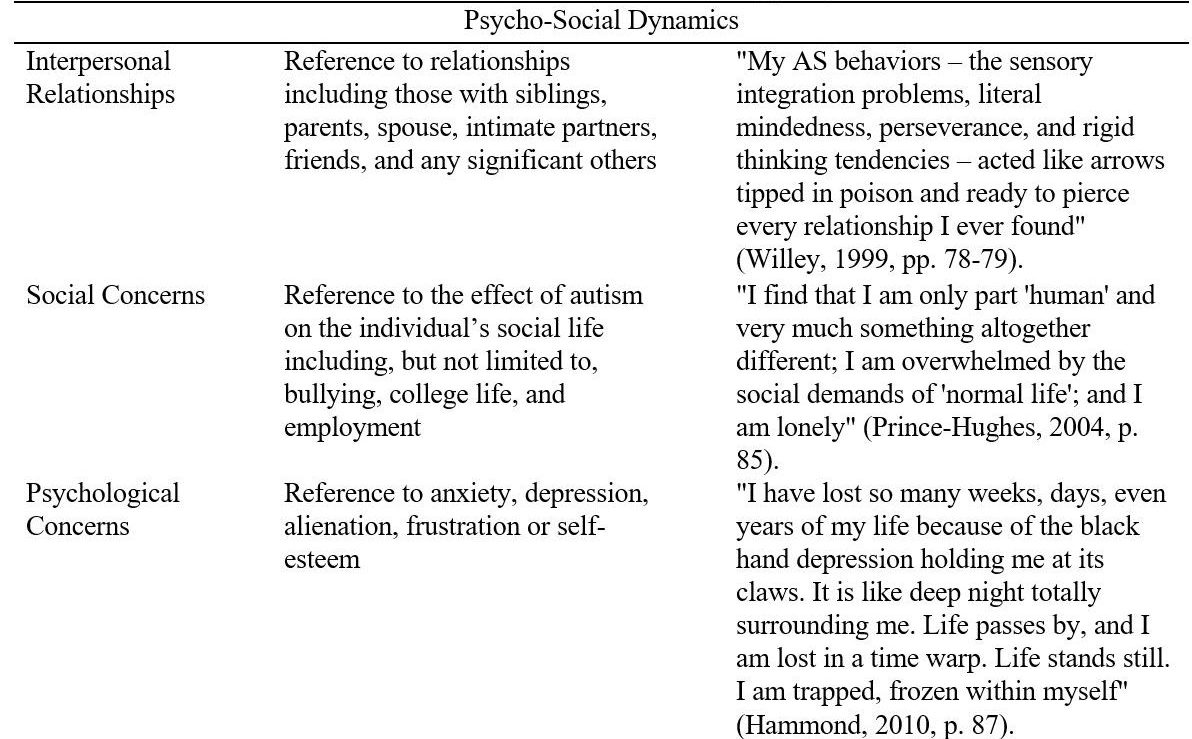
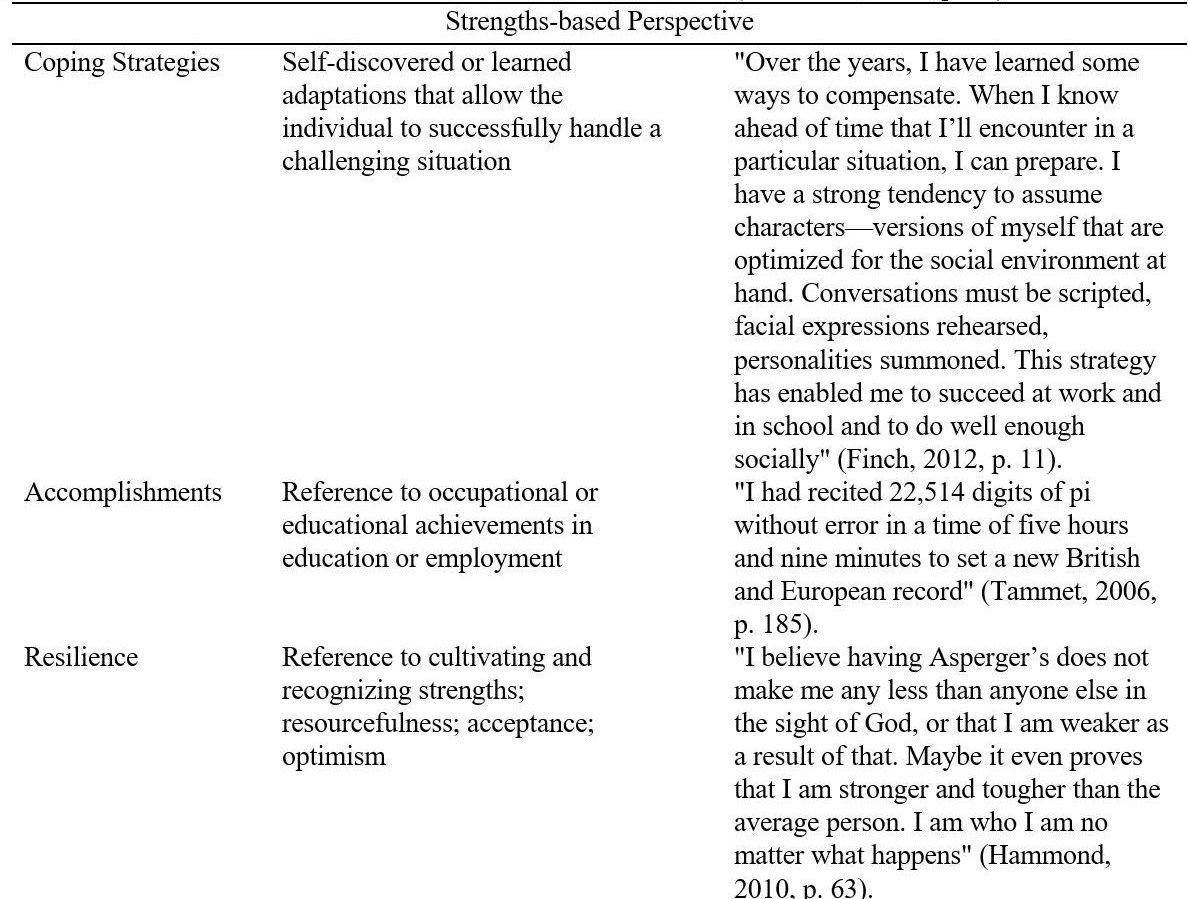

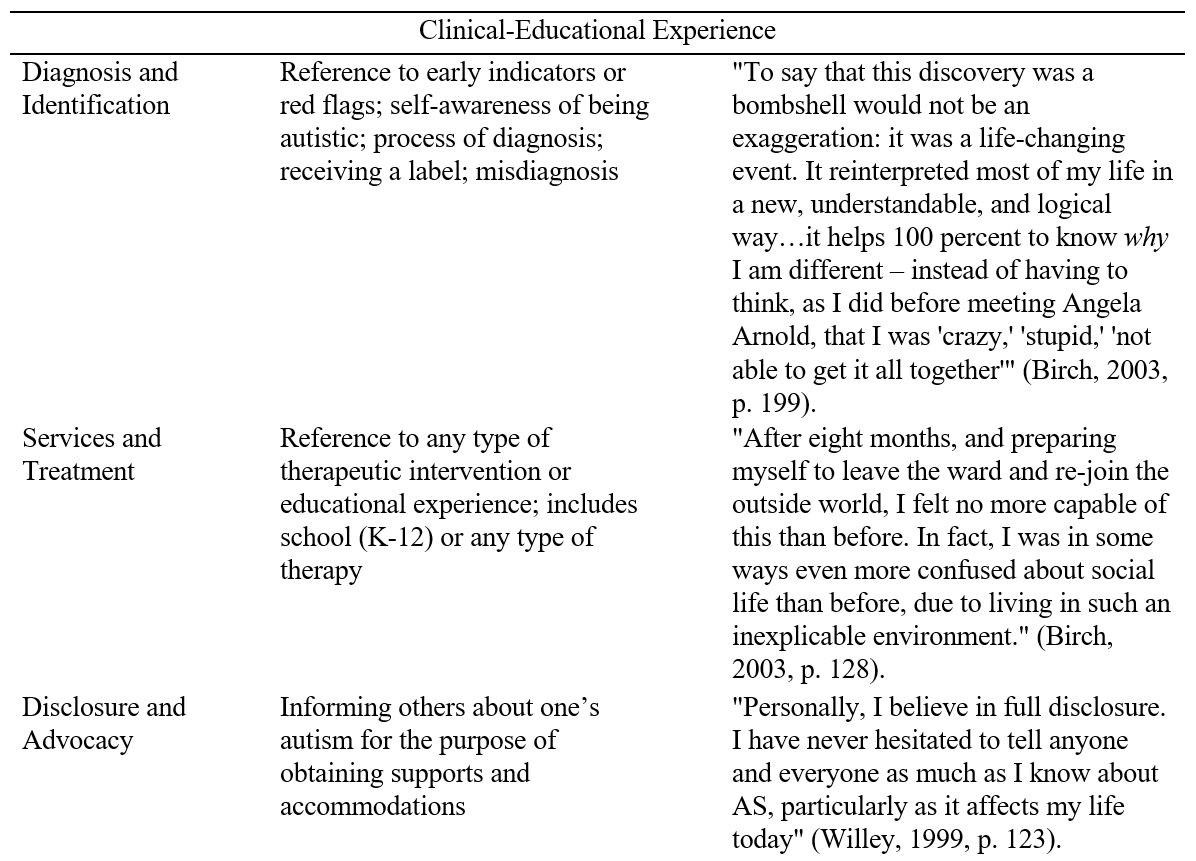
Hierarchical Themes. The third research question asked which broad-based themes capture the content of the autobiographies. Five themes captured the 18 categories that emerged from the readings. The Differences theme included the cognitive, speech-language, behavioral, sensory, deep interests, and medical categories. Differences were conceived relative to neurotypicals, a term that originated with the neurodiversity movement (Brownlow, 2010). The Psychosocial Dynamics theme consisted of the interpersonal relationships, social concerns, and psychological concerns categories. The Strengths-based Perspective theme consisted of the accomplishments, resilience, and coping strategies categories. The Pedagogy theme consisted of the didactic mode, autism identities and culture, and historical perspectives categories. The Clinical-educational Experience theme consisted of the diagnosis/identification, services/treatment, and disclosure/advocacy categories. Figure 1 contains the number and percent of instances of the 18 categories within and across the five themes across all books. The Differences theme was the most prevalent, accounting for 42% of the data. The four remaining themes, Psychosocial Dynamics, Strengths-based Perspective, Pedagogy, and Clinical-educational Experience, together accounted for 58% of the remaining data in descending frequency of occurrence.
The 18 content categories were well represented across the autobiographies. Three of the books, all written by authors with Asperger’s Syndrome (AS), demonstrated all of them (Carley, 2008; Hammond, 2010; Shore, 2003) and three included 17 (Birch, 2012; Paradiž, 2002; Prince-Hughes, 2004). Two of the books incorporated 16 of the categories (Robison, 2008; Williams, 1994) and four contained 15 (Finch, 2012; Lawson, 2000; Tammet, 2007; Willey, 1999). These results indicate that the content categories recurred across the selected autobiographies suggesting that, in answer to the first research question, the narratives do contain consistent topics, ideas, or concerns.
Certain autobiographies varied in their focus on a particular category. For example, Birch (2003) contained 51 instances of the cognitive differences category. In fact, all six categories within the Differences theme were prevalent throughout her book. However, Birch’s focus on the Pedagogy theme was limited, as her autobiography exhibited no instances of autism identities and culture, a category within that theme. In contrast, Carley (2008) emphasized autism identities and culture with 22 instances of that category, but the cognitive differences category was coded only twice. Other categories within the Differences theme were less prevalent in his book suggesting that these were not dominant (see Table 1). The second research question asked which categories are most prevalent in the autism autobiographies. The answer to this question allowed for the identification of books that align with particular aspects of autism. Table 1 lists the three most dominant categories for each autobiography, with their proportional frequency of occurrence within that book.
Discussion
Analysis, Clinical-educational Implications, and Limitations
This study analyzed twelve autism autobiographies published between 1994 and 2012, the years when Asperger syndrome was part of the DSM-IV (American Psychiatric Association, 1994). This period was characterized by greater public awareness about autism and Asperger syndrome (Heilker & Yergeau, 2011), a growing respect for differences (Bates, 2010; Brownlow, 2009), increased recognition of neurodiversity (Van Goidsenhoven & Masschelein, 2016; Brownlow, 2010), an established disability rights movement (Solomon, 2008), and the proliferation of autism advocacy organizations (Solomon, 2008). In terms of the literature reviewed, this investigation, not surprisingly, found some of the same categories that were identified in previous autism autobiographical research that analyzed some of the same stories —Birch’s Congratulations! It’s Asperger Syndrome, Lawson’s Life behind Glass, Prince-Hughes’ Songs of the Gorilla Nation, Robison’s Look Me in the Eye, Shore’s Beyond the Wall, Tammet’s Born on a Blue Day, Willey’s Pretending to be Normal, and Williams’s Somebody Somewhere (Causton-Theoharis, Ashby, & Cosier, 2009; Conn 2015; Costa & Grinker, 2018; Duffy & Dorner, 2011; Hacking, 2009; Murray, 2008). The current study, consistent with previous investigations, identified themes such as Differences (Foss, 2009), especially sensory issues (Causton-Theoharis, Ashby, & Cosier, 2009; Conn, 2015; Davidson and Henderson, 2010; Vincent et al., 2017), accomplishments and resilience (Foss, 2009; Vincent et al., 2017), social concerns and interpersonal relationships (Causton-Theoharis, Ashby, & Cosier, 2009; Vincent et al., 2017). The categories of diagnosis and identification as well as autism identities and culture were also previously investigated, although in only one previous study (Foss, 2009).
Four of the autobiographies analyzed for this research (Carley’s Asperger from the Inside Out, Finch’s Journal of Best Practices, Hammond’s My Life with Asperger’s, and Paradiž’s Elijah’s Cup) had not been previously investigated. Based on our search of the extant literature, this was the first study to analyze those autobiographies. Paradiž wrote primarily about cognitive, speech-language, and sensory differences. Hammond and Finch highlighted interpersonal relationships. Finch and Carley emphasized various coping strategies used to address challenges. Carley wrote didactically with an eye toward explicitly informing his audience about some aspect of autism and Asperger syndrome. Paradiž and Carley emphasized autism identities and culture.
The results of this research indicated that the selected autism autobiographies contain consistent, recurrent themes that could increase students’ depth of understanding of autism. The twelve autobiographers investigated here wrote mostly about their differences, which accounted for 42% of the thematic content in the present study. Six categories were subsumed under the Differences theme whereas only three categories were subsumed under each of the other four themes. The larger number of categories subsumed under the Differences theme could account for the greater number of instances of that theme relative to the other four which each had three categories. However, even if the number of instances in the Differences theme (n=836) were halved (n=418), it would still be the theme with the largest number of instances.
The background literature reviewed for this study reported some similar findings regarding the Differences theme. For example, Davidson and Henderson’s (2010) work on full-length autobiographies and collections of personal stories focused exclusively on sensory issues. Hacking (2009) reported that the four autistic autobiographers he studied wrote about their sensory experiences and behaviors. These two categories accounted for 13.3% of the data in the present study and appeared with greater frequency in four of the autobiographies, namely, those by Birch (2010), Lawson (2000), Paradiž (2002), and Tammet (2007).
Although the categories that emerged from the life stories were not pre-determined, some of those that were identified upon reading the texts reflected its authors’ clinical backgrounds in the field of speech-language pathology. For example, the diagnosis/identification and services/treatment categories subsumed under the Clinical-educational Experience theme were familiar constructs for the investigators. However, the researchers did not anticipate disclosure/advocacy, the other category in Clinical-educational Experiences theme, which seemed to reflect the autistic authors’ inside perspective and an important topic in disability studies. Similarly, the three categories subsumed under the Strengths-based Perspective theme, namely accomplishments, resilience, and coping strategies, reflected the voices of those on the spectrum. Thus, the analysis of the twelve selected texts reflected both the outside clinical and the inside autistic perspectives.
Despite their training as speech-language pathologists, the authors of this study attempted to minimize the ableist, normative language of “differentiation and division” (Duffy & Dorner, 2011, p. 211) that typifies much of the clinical literature based on the medical model. Instead, they endeavored to frame the content of the autobiographies in the language of neurodiversity, “embracing a wide range of neurological makeups, autistic being one of them” (Brownlow, 2010, p. 252). For example, one of the core characteristics of autism is the presence of repetitive behaviors and restricted interests (American Psychological Association, 2013). This notion of “restricted interests,” which is framed in a deficit perspective, can be conceived in terms of “deep and focused interests” (Paradiž, 2012, p. 71), talents that could develop into life-long careers or hobbies (Grandin & Duffy, 2008). This view echoes Prizant’s (2015) observation that what some might call autistic obsessions can be viewed as “passions.” In addition, the authors decided to use “Speech-Language Differences” as a category rather than the DSM-5 characterization of the other core characteristic of ASD as “deficits in social-emotional reciprocity and nonverbal communicative behaviors” (American Psychological Association, 2013, p. 50). Embracing alternative representations of autism as an example of neurodiversity, rather than impairment, has broad connections to the disability literature and the social model (Brownlow, 2007).
Clinical-educational Implications
Knowing which books relate to specific content areas could interest pre-service clinical students in preparing for different fields. For example, psychology students might find the life-stories that emphasize cognitive or behavioral difference as particularly relevant to their education, such as those by Birch (2012), Lawson (2000), Tammet (2007), Willey (1999), and Williams (1994). Psychology, social work, and education students might also benefit from reading the works by Finch (2012) and Lawson (2000), which emphasize interpersonal relationships and social concerns. Speech-language pathology students, such as the one mentioned in the opening paragraph of this article, could benefit from reading the books by Finch (2012), Paradiž (2002), Robison (2008), Tammet (2007), and Willey (1999), which emphasize speech-language differences. Both speech-language pathology and psychology students could learn from Tammet’s (2007) autobiography, which emphasizes the cognitive, behavioral, and speech-language categories of difference. Career counsellors and disability service providers in university settings might be interested in autobiographies that focus on deep interests, such as the one by Birch (2003), which could guide individuals on the spectrum to explore career choices that capitalize on their passions and strengths, with an eye toward steering them toward meaningful work. This becomes important in light of the fact that individuals with autism are usually unemployed or underemployed (Hendricks, 2009).
Not surprisingly, Clinical-educational Experience was the theme least emphasized across the twelve books. This suggests that, although autistic autobiographers wrote extensively about their differences, they wrote less frequently about the clinical-educational management of those differences. This finding was consistent with the themes in the Brownlow’s analysis of asynchronous online discussion among subjects on the autism spectrum who rejected the idea of making people “more normal” and “less autistic” through therapeutic intervention (Brownlow & O’Dell, 2009, p. 7). The only autism autobiography analyzed in this study that highlighted the process of diagnosis and identification was Hammond’s (2010). The related topics of services, treatment, disclosure, and advocacy together accounted for only 4.3 % of the content across the twelve books. In contrast, the autistic autobiographers wrote more often about their resilience, accomplishments, and coping strategies adopting a strengths-based perspective on their lives, which accounted for 16.1% of the content across books. Narratives by Carley (2008) and Shore (2003) were notable for their use of the didactic category in which they explicitly provided their readers with information about the autism spectrum.
The autobiographical accounts analyzed for this study provide insight into autism identities and culture, especially the books by Carley (2008) and Paradiž (2003). The autobiographies by Prince-Hughes (2004), Robinson (2008), and Shore (2003) refer to their accomplishments more frequently than in the other books. Further, all of these authors shed a positive light on autism with their emphasis on difference rather than disorder or disability. Reading about the accomplishments and resilience of others on the spectrum fosters positive self-identities and garners increased understanding from those who inhabit the neurotypical world. The books by Carley (2008) and Finch (2012) expose the reader to the coping strategies they used successfully to navigate challenging situations. Finally, these stories can offer those with autism and their significant others a greater understanding of life on the spectrum. In referring to his own autobiography, Stephen Shore (2003) states
…if this work has assisted even one person in developing a more meaningful relationship with a person on the autism spectrum; if only one person with autism had been helped— then I have achieved my goal of developing more understanding and building bridges to a better tomorrow. (p. 184)
In discussing the creation of natural critical learning environments in higher education, Bain (2004) notes that students in clinically oriented programs such as speech-language pathology learn best when confronted with “real clinical cases” (p. 106). Davidson and Henderson (2010) note “an original work is almost always the richest source of insight” (p. 473) and provides a “contextualized and complex” (p. 473) approach to understanding the nature of the differences in individuals with autism. In teaching about varied disabilities, Smead (1999) provides her university students with “specific people in specific situations” (p. 79). Smith-Chandler and Swart (2014) note that disability narratives challenge negative stereotypes. The twelve autobiographies analyzed for the present study could serve as teaching tools on the university level. They encourage students to think critically and broadly about autism in relation to a variety of clinically oriented academic disciplines, such as education, psychology, and speech-language pathology. A specific book could be selected as a common read, which all students discuss. Alternatively, individual students or small groups could read different books, sharing their reactions, thoughts, and impressions with other members of the class. A template such as the one developed for this investigation could be used to guide their reading, or students could develop their own analytic tool.
Personal narratives have gained wider acceptance in the medical, clinical, and educational fields as a means of training future professionals. Autism autobiographies, including those that are commercially successful, have de-stigmatized autism and contributed to broader views of neurodiversity that benefit all (Van Goidsenhoven & Masschelein, 2016). Of note, three of the autobiographies that were analyzed for this research appeared on The New York Times Best Sellers list (i.e., Finch, 2012; Robison, 2008; Tammet, 2007) and some autism autobiographies are in their second edition (e.g., Shore, 2003; Tammet, 2007; Willey 2015). A revised edition of Elijah’s Cup (Paradiž, 2002) was published in 2005. For further discussion regarding the relationship of publishing to autism autobiographies the reader is referred to Garden (2010), Rose (2008), and Van Goidsenhoven and Masschelein (2016).
Limitations. This research used a small sample size since it involved only twelve autism autobiographies, all published in English and written by speaking adults on the spectrum. More individuals with autism had written their stories (e.g., Blackman, 2001; Gerland, 2003; Hammerschmidt, 2008; Mukhopadhyay, 2000; 2008; Sanders, 2004; Saperstein, 2010) by the time this research began, but a decision was made to limit the number analyzed (see Rose 2005, for additional titles) to make the analysis of data more manageable within a reasonable time frame. An additional limitation is that autism autobiographies represent only those who are verbally and cognitively able to convey their experiences eloquently in written text, consequently excluding those who are unable to express themselves through conventional written language. This limits the generalizability of the findings because the sample is not representative across the broad spectrum of individuals with ASD. This factor also results from the non-random selection of autism autobiographies. Further, only one genre of autobiographical writing, the book-length narrative, was analyzed for this study. Collections of essay-length personal accounts by persons with autism (e.g. Grandin 2012; Perner 2012; Prince-Hughes 2002) and other genres of writing such as poetry and blogs (e.g., The Aspie Life (Soraya, 2019), The Autism Diva (2018), and Whose Planet Is It Anyway? (“abfh,” 2010) were excluded from the study and merit their own review. Duffy and Dorner (2011) note that blogs and You Tube videos, such as Amanda Baggs’s (2007) In My Language video, provide additional venues for “autistic presence” (Murray, 2008), as do the some autism advocacy websites (e.g. . Brownlow’s (2007) study of online discussions by people on the autism spectrum revealed that diagnosis including self-diagnosis, therapeutic interventions, and autism spectrum identities were among the topics in Internet discussions.
Future Research
Future research should involve analysis of additional autism memoirs including those written in languages other than English, those by adolescent authors, authors from diverse backgrounds, non-speaking authors, and those who co-authored with parents. In addition to the full-length autobiography, other narrative forms, such as essay-length accounts, should be investigated. Future research would evaluate the generalizability of the content categories, themes, and organizational framework described here to study other autism autobiographies and, perhaps, other forms of life writing. That framework should be evaluated for applications and adaptations in a variety of courses including clinical/educational practicum seminars and independent studies. Students who read similar texts or other genres of narrative would evaluate or even revise the framework. Students would identify particular aspects of the disability about which they had limited knowledge prior to reading the personal account and report how reading the autobiography shifted or expanded their thinking. Future research would also identify additional categories that could be classified as strengths, such as different areas of accomplishment and various types of coping strategies. In addition, because the Differences theme was so large, additional studies can seek to distinguish those differences that are strengths from those that are challenges.
Future research should also examine the age of the authors at the time of diagnosis, as this could be a mediating variable that impacts the broad-based themes and categories. For example, diagnosis as an adult versus as a child would impact the receipt of services and treatment, coping strategies, interpersonal relationships, as well as psychological and social concerns. Age of diagnosis would have had a potential role in the results of the present investigation and warrant future research. Similarly, differences in age of diagnosis or self-diagnosis of authors with Asperger’s syndrome as compared with ASD may have influenced their experiences with the broad-based themes and categories such as clinical-educational experience. Future research should also focus on students’ responses to the autobiographies in terms of how they expanded their views of this disability and the ways in which they found them helpful, insightful, and complementary to textbooks and other traditional sources of information.
Summary and Conclusions
This study consisted of a thematic content analysis of twelve full-length autism autobiographies published between 1994 and 2012. Eighteen categories and five broad themes captured the content of these books. The autistic autobiographers wrote most frequently about their differences and least frequently about their clinical-educational experience. The strengths-based perspective of these autobiographies provides readers with the inside perspective of life on the autism spectrum and can enhance pre-service clinical education in various fields. The authors of this study join autobiographer and autism advocate Liane Holliday Willey (1999) with hope that
…as society continues to break the boundaries of normal, the boundaries so many cannot see and so many cannot find, this blight which robs good people of growth and happiness will ebb into a distant hollow, unseen and forgettable. And then, maybe then, the world really will welcome all people (p. 75).
Acknowledgments: The authors wish to acknowledge those individuals on the autism spectrum whose autobiographies informed this work and the assistance of Matthew Harrick and Mariana Regalado of the Brooklyn College library.
Funding: This work was funded in part through a Professional Staff Congress (PSC) award from the City University of New York (CUNY), to the first author.
References
“abfh” [autisticbfh] & Skeeter, R. (2010). Whose Planet is it Anyway? [Blog]. Retrieved from http://autisticbfh.blogspot.com/
American Psychiatric Association. (1994). Diagnostic and statistical manual of mental disorders, fourth edition (DSM-IV). Washington, DC: Author.
American Psychiatric Association. (2013). Diagnostic and statistical manual of mental disorders, fifth edition (DSM-5). Washington, DC: Author.
ASAN. (2019). [Autism Self Advocacy Network, a 501(c)(3) nonprofit organization run by and for autistic people.]. Retrieved from https://autisticadvocacy.org/
Autism Diva, The. (2018). (Website resource for families with special needs). Retrieved from https://www.theautismdiva.com/about-us/
Autism Network International (2011). [autistic-run self-help and advocacy]. Retrieved from https://www.autismnetworkinternational.org/
Baggs, A. (2007, January 14). In my language [Video file]. Retrieved from https://www.youtube.com/watch?v=JnylM1hI2jc/
Bain, K. (2004). What the best college teachers do. Cambridge, MA: Harvard University Press.
Baio, J., Wiggins, L., Christensen D., Maenner, M. J., Daniels, J., Warren, Z.,…Dowling, N. (2014). Prevalence of autism spectrum spectrum disorder among children aged 8 years. Retrieved from doi:10.15585/mmwr.ss6706a1
Bates, G. (2010). Autism in fiction and autobiography. Advances in Psychiatric Treatment, 16(1), 47-52. doi:0.1192/apt.bp.108.005660
Birch, J. (2012). Congratulations! It’s Asperger syndrome. London, England: Jessica Kingsley Publishers.
Blackman, L. (2001). Lucy’s story: Autism and other adventures. (2nd ed.) London, England: Jessica Kingsley.
Braun, V., & Clarke, V. (2006). Using thematic analysis in psychology. Qualitative Research in Psychology, 3, 77-101. doi:10.1191/1478088706qp063oa
Brownlow, C. (2007). The construction of the autistic individual: Investigations in online discussion groups (Unpublished doctoral dissertation). England.
Brownlow, C. (2010). Re-presenting autism: The construction of ‘NT syndrome.’ Journal of Medical Humanities, 31(3), 243-255. Retrieved from https://www.ncbi.nlm.nih.gov/pubmed/20369278
Brownlow, C., & O’Dell, L. (2009). Representations of autism: Implications for community healthcare practice. Community Practitioner, 82(7), 18-21.
Carley, M. J. (2008). Asperger’s from the inside out: A supportive and practical guide for anyone with Asperger’s syndrome. New York, NY: Penguin Group.
Causton-Theoharis, J., Ashby, C., & Cosier, M. (2009). Islands of loneliness: Exploring social
interaction through the autobiographies of individuals with autism. Intellectual and Developmental Disabilities, 47, 84-96. doi:10.1352/1934-9556-47.2.84
Conn, C. (2015). ‘Sensory highs,’ ‘vivid rememberings’ and ‘interactive stimming’: Children’s
play cultures and experiences of friendship in autistic autobiographies, Disability & Society, 30(8), 1192-1206. doi:10.1080/09687599.2015.1081094
Costa, J. F., & Grinker, R. R. (2018). Autism and first-person accounts: The cognitive problem. In E. Fein & C. Rios (Eds.) Autism in translation: An intercultural conversation on autism spectrum conditions (pp. 155-174). London, England: Palgrave Macmillan.
Couser, G. T. (2011). Introduction: Disability and life writing. Journal of Literary & Cultural
Disability Studies, 5(3), 229–242. doi:10.3828/jlcds.2011.20
Damico, J. S., & Simmons-Mackie, N. N. (2003). Qualitative research and speech-language pathology: A tutorial for the clinical realm. American Journal of Speech-Language Pathology, 12, 131-143. doi:10.1044/1058-0360(2003/060)
Davidson, J., & Henderson, V. L. (2010). ‘Travel in parallel with us for a while’: Sensory geographies of autism. The Canadian Geographer, 54, 462-475. doi:10.1111/j.1541-0064.2010.00309.x
Draaisma, D. (2009). Stereotypes of autism. Philosophical Transactions of the Royal Society B: Biological Sciences, 364(1522), 1475-1480. doi:10.1098/rstb.2008.0324
Duffy, J., & Dorner, R. (2011). The pathos of “mindblindness”: Autism, science, and sadness in “theory of mind” narratives. Journal of Literary & Cultural Disability Studies, 5, 201-215. doi:10.3828/jlcds.2011.16
Dunn, D. S., & Burcaw, S. (2013). Disability identity: Exploring narrative accounts of disability. Rehabilitation Psychology, 58(2), 148-157. doi:10.1037/a0031691
Finch, D. (2012). Journal of best practices. A memoir of marriage, Asperger syndrome, and one man’s quest to be a better husband. New York, NY: Scribner.
Fletcher-Watson, S., & Happé, F. (2019). Autism: A new introduction to psychological theory and current debate (2nd ed.). New York, NY: Routledge.
Foss, C. (2009). Emerging from emergence: Toward a rethinking of the recovery story in nine contemporary nonfiction autism narratives. Disability Studies Quarterly, 29(2).
Garden, R. (2010). Telling stories about illness and disability: The limits and lessons of narrative. Perspectives in Biology and Medicine, 53, 121-135. Retrieved from https://www.ncbi.nlm.nih.gov/pubmed/20173300
Gerland, G. (2003). A real person: Life on the outside. London, England: Souvenir Press.
Grandin, T. (2012). Different…not less: Inspiring stories of achievement and successful employment from adults with autism, Asperger’s, and ADHD. Arlington, TX: Future Horizons.Grandin, T., & Duffy, K. (2008). Developing talents: Careers for individuals with Asperger syndrome and high-functioning autism. Shawnee Mission, KS: Autism Asperger Publishing Company.
Grandin, T., & Scariano, M. M. (1986). Emergence: Labeled autistic. Novato, CA: Arena Press.
Hacking, I. (2009). Autistic autobiography. Philosophical Transactions: Biological Sciences, 364, 1467-1473. Retrieved from https://www.ncbi.nlm.nih.gov/pubmed/19528032
Hammerschmidt, E. (2008). Born on the wrong planet. Shawnee Mission, KS: Autism Asperger Publishing Company.
Hammond, M. (2010). My life with Asperger’s. Sydney, Australia: New Holland.
Happé, F., Briskman, J., & Frith, U. (2001). Exploring the cognitive phenotype of autism: Weak “central coherence” in parents and siblings of children with autism: 1 Experimental tests. The Journal of Child Psychology and Biology, 43(2), 299-307.
Heilker, P., & Yergeau, M. (2011). Autism and rhetoric. College English, 73(5), 485-497.
Hendricks, D. (2010). Employment and adults with autism spectrum disorders: Challenges and strategies for success. Journal of Vocational Rehabilitation, 32, 125–134. Retrieved from https://worksupport.com/documents/JVRautismHendricks.pdf
Higashida, N. (2013). The reason I jump. New York, NY: Random House.
Jack, J. (2012). Gender copia: Feminist rhetorical perspectives on an autistic concept of sex/gender. Women’s Studies in Communication, 35, 1-17. doi:10.1080/07491409.2012.667519
Kern-Stähler, A., & Thiemann, A. (2015). Autism and the American dream: Progress and
recovery in the American autie-biography. In F. Gygax & M. A. Locher (Eds.), Narrative matters in medical contexts across disciplines (pp. 17-30). Philadelphia, PA: John Benjamins Publishing Co.
Kluth, P. (2004). Autism, autobiography, and adaptations. Teaching Exceptional Children, 36(4), 42-47. doi:10.1177/004005990403600406
Kramp, M. K. (2004). Exploring life and experience through narrative inquiry. In K. deMarrais, & S. D. Lapan (Eds.). Foundations for research: Methods of inquiry in education and the social Sciences (pp. 103-121). Lawrence Erlbaum Associates, Mahwah, NJ. Retrieved from http://citeseerx.ist.psu.edu/viewdoc/download?doi=10.1.1.453.8428&rep=rep1&type=pdf
Lawson, W. (2000). Life behind glass: A personal account of autism spectrum disorder. Philadelphia, PA: Jessica Kingsley Publishers.
Maxwell, D. L., & Satake, E. (2006). Research and statistical methods in communication sciences and disorders. Clifton Park, NY: Thomson Delmar Learning.
Murray, S. (2008). On autistic presence. Journal of Literary and Cultural Disability Studies, (2)1. doi:10.3828/jlcds.2.1.2
Mukhopadhyay, T. R. (2000). Beyond the silence: My life, the world and autism. London, England: The National Autistic Society.
Mukhopadhyay, T. R. (2011). How can I talk if my lips don’t move?: Inside my autistic mind. New York, NY: Arcade.
Paradiž, V. (2002). Elijah’s cup: A family’s journey into the community and culture of high-functioning autism and Asperger’s syndrome. New York, NY: The Free Press.
Paradiž, V. (2005). Elijah’s cup: A family’s journey into the community and culture of high-functioning autism and Asperger’s syndrome. London, England:
Paradiž, V. (2012). Deep thinking on baseball and autism. In L. Perner (Ed.), Scholars with autism achieving dreams (pp. 71-92). Sedona, AZ: Auricle Ink.Perner, L. (2012). Scholars with autism achieving dreams. Sedona, AZ: Auricle Ink.
Prince-Hughes, D. (2002). Aquamarine blue 5: Personal stories of college students with autism. Athens, OH: Swallow Press.
Prince-Hughes, D. (2004). Songs of the gorilla nation: My journey through autism. Goshen, NY: Harmony.
Prizant, B. M., & Fields-Meyer, T. (2015). Uniquely human: A different way of seeing autism. New York: NY: Simon and Schuster, Inc.
Robison, J. E. (2008). Look me in the eye: My life with Asperger’s. New York, NY: Bantam.
Rose, I. (2005). Autistic autobiography: Introducing the field [Panel discussion]. Proceedings of S. C. E. conference, Case Western Reserve University [link to Autistic Autobiography word file download], October 2005. Autism and Representation: Writing, Cognition, Disability. Retrieved from https://case.edu/affil/sce/Texts_2005/Autism and Representation Rose.htm
Rose, I. (2008). Autistic autobiography or autistic life narrative? Journal of Literary and Cultural Disability Studies 2(1), 44-54. doi:10.3828/jlcds.2.1.6
Sanders, R. (2004). On my own terms: My journey with Asperger’s. Murfreesboro, TN: Armstrong Valley Publishing Co.
Saperstein, J. (2010). Getting a life with Asperger’s: Lessons learned on the bumpy road to adulthood. New York, NY: Penguin.
Shore, S. M. (2003). Beyond the wall: Personal experiences with autism and Asperger syndrome, (2nd ed.). Shawnee Mission, KS: Autism Asperger Publishing Company.
Smead, V. (1999). Personal accounts of exceptionality: An untapped resource for child services professionals. Intervention in School and Clinic, 35, 79-86. doi:10.1177/105345129903500203
Smith-Chandler, N., & Swart, E. (2014). In their own voices: Methodological considerations in narrative disability research. Qualitative Health Research, 23(3), 420-430. doi:10.1177/1049732314523841
Solomon, A. (2008, May 23). The autism rights movement. New York Magazine. Retrieved from http://nymag.com/news/features/47225/
Soraya, Lynne. (2019). The Aspie Life [blog]. Retrieved from http://aspielife.blogspot.com/
Stern, D. (1995). The motherhood constellation: A unified view of parent-infant psychotherapy. London, England: Routledge.
Tammet, D. (2006). Born on a blue day: A memoir of Asperger’s and an extraordinary mind. London, England: Hodder & Stoughton.
Tammet, D. (2007). Born on a blue day: Inside the extraordinary mind of an autistic savant. New York, NY: The Free Press.
Tomlinson, E., & Newman, S. (2017). Valuing writers from a neurodiversity perspective: Integrating new research on autism spectrum disorder into composition pedagogy. Composition Studies, 45(2), 91-112. doi:10.1080/13569783.2016.1195121
Van Goidsenhoven, L. (2017). ‘Autie-biographies’: Life writing genres and strategies from an autistic perspective. Language, Literature and Culture 64(2), 79-95. doi:10.1080/20512856.2017.1348054
Van Goidsenhoven, L., & Masschelein, A. (2016). Donna Williams’s ‘triumph’: Looking for ‘the place in the middle’ at Jessica Kingsley Publishers. Life Writing 15(1), 1-23.
Vincent, J., Potts, M., Fletcher, D., Hodges, S., Howell, J., Mitchell, A.,… & Ledger, T. (2017). ‘I think autism is like running on windows while everyone else is a mac’: Using a participatory action research approach with students on the autistic spectrum to rearticulate autism and the lived experience of university. Educational Action Research, 25(2), 300-315. doi:10.1080/09650792.2016.1153978
Volkmar, F. R., & Wiesner, L. A. (2009) A practical guide to autism: What every parent, family member, and teacher needs to know. Hoboken, NJ: John Wiley & Sons, Inc.
Volkmar, F. R., Rogers, S. J., Paul, R., & Pelphrey, K. A. (2014). Handbook of autism and pervasive developmental disorders (4th ed.). Hoboken, NJ: John Wiley & Sons, Inc.
Willey, L. H. (1999). Pretending to be normal: Living with Asperger’s syndrome. Philadelphia, PA: Jessica Kingsley Publishers.
Willey, L. H. (2015). Pretending to be normal: Living with Asperger’s syndrome. [Expanded edition]. London, England; Philadelphia, PA: Jessica Kingsley Publishers.
Williams, D. (1992). Nobody nowhere: The remarkable autobiography of an autistic girl. London, England: Jessica Kingsley Publishers.
Williams, D. (1994). Somebody somewhere: Breaking free from the world of autism. New York, NY: Three Rivers Press.
Appendix
Example of a blank coding form
Complete book citation: ______________________________________
